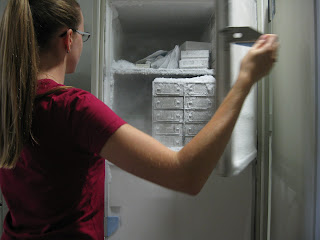108F. That was the real-feel temperature this
afternoon in Iowa City! When I
walked out of the highly air conditioned lab, I felt as if I had walked into a
solid wall of heat. My sunglasses
steamed up and my hands felt clammy due to the sudden increase in
humidity. But when I complained
about the heat, native Iowans told me, “just wait until the end of July, it
gets worse!” Luckily, I won’t have
to find out, as the last day of my internship here is July 16th.
It took me
awhile to decide what to write about in this post because for the last few
weeks I have been doing more or less the same things in lab, but then I thought
of something I haven’t told you guys about yet. C-sections! So
far I have been to three C-sections and in doing so I have witnessed the birth
of four babies. These have been
some of my favorite experiences of the summer so far.
Throughout
rounds in the NICU it is not uncommon for one of the residents’ pagers to go
off; usually it is another department calling to answer a consult or to ask a
question. Sometimes, though, all
four pagers go off loudly at once.
In my experience, this means one thing: more hands are needed in the
operating room! Usually two
residents and a nurse respond to the call, and since I’ve started wearing
scrubs in place of professional clothes, I’m allowed to tag along! The whole thing is very efficient
because the OR is directly next door to the NICU.
We hurry down
the hall to a big cabinet where we dress for the operating room: blue shoe
covers, yellow long-sleeve smock, gloves, mask, and hair-covering. By the time we are all suited up, our
eyes and ears are the only skin showing and it’s nearly impossible to tell us
apart (this makes me feel better going into the OR, because at least I look
like I know what I’m doing). Then
we head through a pair of huge double doors. By the time we arrive, the surgeons are
already well on their way to opening the uterus. In subsequent conversations with my housemates, I’ve learned
that C-sections are well known to be some of the “goriest” surgeries simply due
to the volume of blood and fluid that is involved. I didn’t know this my first time observing though, and I was
glad my mask covered me as I stared open mouthed at the outpouring of blood. When the surgeons finally punctured the
amniotic sac, my first thought was of a volcano; suddenly I understood why the
surgeons had plastic shields covering their faces from mouth to forehead.
Once the
incision is made, the surgeons pull the baby out - a task which turns out to be
very laborious. They pull and push
and strain until finally the infant slips out and is handed immediately to the
baby team (in this case, the NICU residents). It is the baby team’s job to rub and suction the baby until
it cries, then clean and swaddle it.
One of the babies I saw delivered weighed over 10 lbs! She looked HUGE compared to the tiny
infants I’m used to seeing in the NICU.
The delivering surgeon was petite, and clearly had to struggle to pull
the baby out. As another surgeon,
observing next to me, said into my ear, “poor thing, that baby is bigger than
she is!”
During each
baby’s first few minutes of life, I like to watch the family members who are
present in the operating room; sometimes the father has come, other times it is
a sister or grandmother. But
without fail, they all tear up and watch in joyous disbelief as the newest
member of their family turns pink and wails. It reminds me of how wonderful life is, and of all the
amazing potential ahead of every newborn.
Meanwhile, the baby team takes the new baby to “Transition” where it
will prepare to go home, and heads back to finish rounds in the NICU. They treat the whole thing as if it is
a perfectly normal occurrence.
It’s not quite normal to me yet though, and I count myself lucky to work with people for whom bringing new life into this world is all in a
day’s work.





